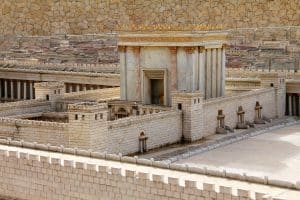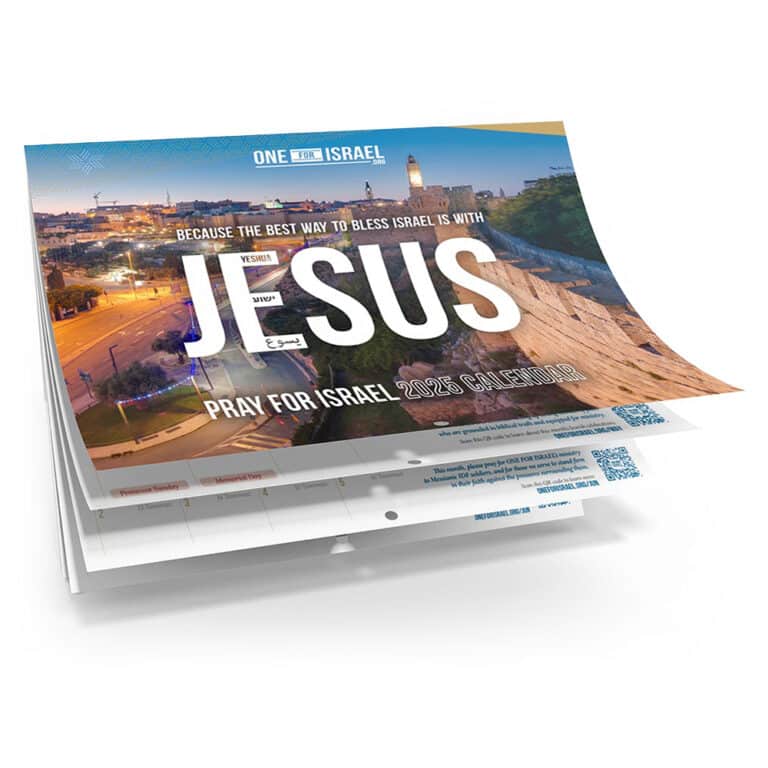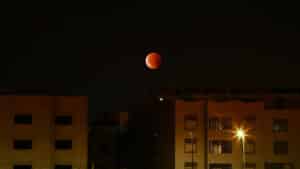The so-called “scarlet thread” of redemption runs throughout the Bible—from the wrist of Judah’s son to Rahab’s rope… it’s there woven into priestly garments and throughout the textiles in the tabernacle—a consistent clue about the Messiah. But did you know that the scarlet thread runs all the way into the Talmud, as a clue to the salvation procured by Messiah’s perfect sacrifice?
The Scarlet Thread of the Second Temple

During the Second Temple era, it was tradition that a scarlet thread, made from wool, was fastened to the door of the temple, and later tied to the head of the scapegoat on the Day of Atonement. Once all the commandments had been scrupulously followed, it is written in ancient literature that this scarlet thread would miraculously become white. It was taken as a sign that God was pleased with the sacrifices, giving reassurance to the people of Israel and that their sin had been successfully atoned for as a nation. If you read carefully all the instructions for Yom Kippur (the Day of Atonement) in the chapter of Leviticus 16, you’ll realize there is quite a lot involved. However, it is the priest who does it all—the people of Israel did nothing but wait in hope for the forgiveness of their sins.
The priest who is anointed and ordained to succeed his father as high priest is to make atonement. He is to put on the sacred linen garments and make atonement for the Most Holy Place, for the tent of meeting and the altar, and for the priests and all the members of the community. This is to be a lasting ordinance for you: Atonement is to be made once a year for all the sins of the Israelites.” (Leviticus 16:32-34)
What a relief, on a national scale, it must have been to know that it’s all been covered and dealt with for a whole year! A whole year of sin wiped out, just like that. God presses the “back to factory settings” button, and the slate is wiped clean for a new start.
The scarlet thread turning white must have been a powerful visual symbol that all was well between Israel and their God for another year. But then something changed…
The paradigm shift circa 30 AD
 Around the time of 30 AD, some forty years before the destruction of the Temple, the scarlet thread suddenly stopped turning white on Yom Kippur. This is recorded in the Talmud in a couple of places:
Around the time of 30 AD, some forty years before the destruction of the Temple, the scarlet thread suddenly stopped turning white on Yom Kippur. This is recorded in the Talmud in a couple of places:
Our Rabbis taught: During the last forty years before the destruction of the Temple the lot [‘For the Lord’] did not come up in the right hand; nor did the crimson-colored strap become white; nor did the westernmost light shine; and the doors of the Hekal [the Temple] would open by themselves… (Tractate Yoma 39b, Soncino Talmud)
‘R. Nahman b. Isaac said it was the tongue of scarlet’, as it has been taught: ‘Originally they used to fasten the thread of scarlet on the door of the [Temple] court on the outside. If it turned white the people used to rejoice, and if it did not turn white they were sad. They therefore made a rule that it should be fastened to the door of the court on the inside. People, however, still peeped in and saw, and if it turned white they rejoiced and if it did not turn white they were sad. They therefore made a rule that half of it should be fastened to the rock and half between the horns of the goat that was sent [to the wilderness]’… If you assume It was R. Johanan b. Zaccai [who made the rule], was there in the days of R. Johanan b. Zaccai a thread of scarlet [which turned white]? Has it not been taught: ‘R. Johanan b. Zaccai lived altogether a hundred and twenty years. For forty years he was in business, forty years he studied, and forty years he taught’, and it has further been taught: ‘For forty years before the destruction of the Temple the thread of scarlet never turned white but it remained red’. (Tractate Rosh Hashanah 31b, Soncino Talmud)
 Some might assert that the scarlet thread ceasing to go white was a sign that the Jews were rejected. However, apart from the fact that all the disciples were Jewish, the entire first church was Jewish, and myriads of believers in the first centuries were Jewish, the Bible explicitly says this is not the case even for those who didn’t believe in Jesus:
Some might assert that the scarlet thread ceasing to go white was a sign that the Jews were rejected. However, apart from the fact that all the disciples were Jewish, the entire first church was Jewish, and myriads of believers in the first centuries were Jewish, the Bible explicitly says this is not the case even for those who didn’t believe in Jesus:
I ask, then, has God rejected his people? By no means! (Romans 11:1)
God’s plan for Israel continues and is being unfolded even as we speak. He is restoring and regathering His people physically, and will also bring spiritual restoration to the whole house of Israel, just as He promised (Ezekiel 37, Romans 11:25, Ezekiel 20:40). What does the sign mean then? It means that animal sacrifices were no longer cutting the mustard in relation to atonement. Ezekiel’s prophesies about the third temple include future sacrifices (chapter 46), but they do not take away sin. Only the blood of Jesus can do that. This has always been the case, and always will be, past, present, and future.
For since the law has but a shadow of the good things to come instead of the true form of these realities, it can never, by the same sacrifices that are continually offered every year, make perfect those who draw near. Otherwise, would they not have ceased to be offered, since the worshipers, having once been cleansed, would no longer have any consciousness of sins? But in these sacrifices there is a reminder of sins every year. For it is impossible for the blood of bulls and goats to take away sins. (Hebrews 10:1-4)
We can repent from our sin and come with a contrite heart, but we no longer stand in condemnation. The Messiah has died for sin once and for all. Forgiveness has now gone viral! The veil in the temple was torn in two, and salvation has gone out to the ends of the earth!
He entered once for all into the holy places, not by means of the blood of goats and calves but by means of his own blood, thus securing an eternal redemption. (Hebrews 9:12)
“The death he died, he died to sin once for all; but the life he lives, he lives to God.” (Romans 6:10)
God does call us to walk in His ways, to turn from evil and to do good, but He has also made provision for our sin. We are already loved and forgiven—the debt was settled and the price was paid 2000 years ago. We don’t have to earn God’s forgiveness, and we couldn’t erase our sin by good deeds even if we wanted to, but God’s got it covered:
“Come now, let us reason together, says the Lord:
though your sins are like scarlet,
they shall be as white as snow;
though they are red like crimson,
they shall become like wool. (Isaiah 1:18)
When Jesus laid down His life as a sacrifice and rose again, the work of atonement was done, once and for all. Completed forever. It is finished. And the scarlet thread monitoring the effectiveness of animal sacrifices each Yom Kippur testified to it.
Whose responsibility is it to save from sin?
Jewish commentators hold that the real reason it stopped turning white was Israel’s moral decline, lack of brotherly love, and the sin of baseless hatred—that this was the reason for the destruction of the temple. They believe that righteousness and love is the key to restoration, and certainly, we’d all be in favor of that! But Yom Kippur was God’s initiative, God is the Savior, not us. He is the only one with power to forgive sin. We cannot cover our own sin by doing good deeds, any more than a thief can hope for exoneration because he helped an old lady across the street.
Our good deeds do not erase the bad.
Only God can do that.
“A certain moneylender had two debtors. One owed five hundred denarii, and the other fifty. When they could not pay, he cancelled the debt of both. Now which of them will love him more?”
Simon answered, “The one, I suppose, for whom he cancelled the larger debt.”
And he said to him, “You have judged rightly.”
Then turning toward the woman he said to Simon, “Do you see this woman? I entered your house; you gave me no water for my feet, but she has wet my feet with her tears and wiped them with her hair. You gave me no kiss, but from the time I came in she has not ceased to kiss my feet. You did not anoint my head with oil, but she has anointed my feet with ointment. Therefore I tell you, her sins, which are many, are forgiven—for she loved much. But he who is forgiven little, loves little.” And he said to her, “Your sins are forgiven.”
Then those who were at table with him began to say among themselves,
“Who is this, who even forgives sins?”
(Luke 7:41-49)
Photo by Aleksandar Živković on Unsplash
















